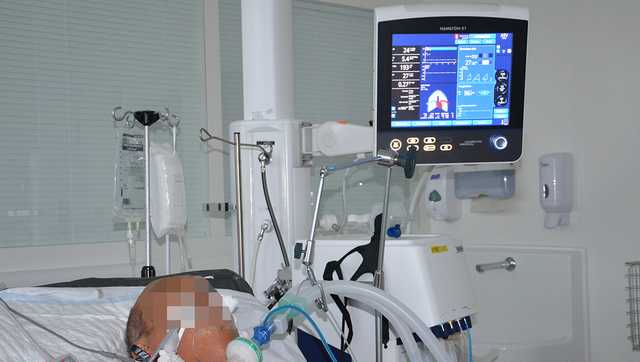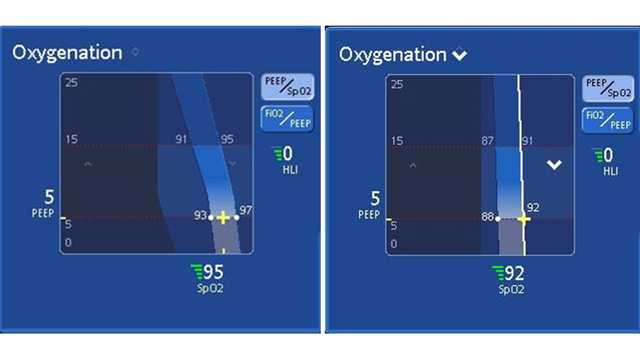
Author: Clinical Experts Group, Hamilton Medical
Date of first publication: 20.04.2020
Hyperoxemia can be defined as an increase in arterial oxygen partial pressure (PaO2) to a level greater than 120 mmHg (16 kPa) (1, 2). It is considered to be moderate for levels ranging between 120 and 200 mmHg, and severe if PaO2 exceeds 200 mmHg (27 kPa) (3). Hyperoxemia is caused by hyperoxia (an increase in oxygen) and occurs in 22% to 50% of mechanically ventilated patients in the ICU (1, 3‑6).

Takeaway messages
- Hyperoxemia can be defined as an increase in arterial oxygen partial pressure (PaO2) to a level greater than 120 mmHg (16 kPa) and may occur in up to 50% of mechanically ventilated patients.
- Retrospective studies have reported hyperoxemia to be associated with the duration of mechanical ventilation, the ICU stay and the hospital stay, as weil as with VAP.
- Avoiding hyperoxemia and targeting physiological ranges of SpO2 and PaO2 in ICU patients may be associated with improved outcomes.
- A closed‑loop oxygenation controller may support this strategy in mechanically ventilated patients, and also reduce the workload for healthcare staff.
U‑shaped relationship between mortality and PaO2
Retrospective studies have reported hyperoxemia to be associated with the duration of mechanical ventilation, of the ICU stay and the hospital stay, as well as with ventilator associated pneumonia (
Comparison of conservative versus conventional oxygen therapy
In 2016, results were published from the first large, prospective randomized controlled trial to test whether a conservative protocol for oxygen supplementation to maintain PaO2 within physiological limits could improve outcomes in ICU patients (
Avoidance of hyperoxemia results in better outcomes
This study shows that avoidance of hyperoxemia is associated with better outcomes, and suggests that clinicians should target physiological ranges of SpO2 and PaO2 in ICU patients. In a pilot, multicenter, randomized controlled trial, a more conservative SpO2 target (88%‑92%) was not associated with better outcomes when compared to a normoxia group (
Maintaining SpO2 within target ranges for mechanically ventilated patients requires a number of daily manual adjustments. INTELLiVENT‑ASV (
Conclusion
In conclusion, avoiding hyperoxemia and targeting physiological ranges for PaO2 and SpO2 in ICU patients is associated with improved outcomes. A closed loop oxygenation controller may help clinicians to apply this strategy in mechanically ventilated patients, and also reduce the workload for healthcare staff.
Full citations below: (
Footnotes
- A. INTELLiVENT‑ASV is not available in the US or on the HAMILTON‑MR1
References
- 1. Panwar R, Hardie M, Bellomo R, et al. Conservative versus Liberal Oxygenation Targets for Mechanically Ventilated Patients. A Pilot Multicenter Randomized Controlled Trial. Am J Respir Crit Care Med. 2016;193(1):43‑51. doi:10.1164/rccm.201505‑1019OC
- 1. de Graaff AE, Dongelmans DA, Binnekade JM, de Jonge E. Clinicians' response to hyperoxia in ventilated patients in a Dutch ICU depends on the level of FiO2. Intensive Care Med. 2011;37(1):46‑51. doi:10.1007/s00134‑010‑2025‑z
- 2. Hafner S, Beloncle F, Koch A, Radermacher P, Asfar P. Hyperoxia in intensive care, emergency, and peri‑operative medicine: Dr. Jekyll or Mr. Hyde? A 2015 update. Ann Intensive Care. 2015;5(1):42. doi:10.1186/s13613‑015‑0084‑6
- 3. Helmerhorst HJ, Arts DL, Schultz MJ, et al. Metrics of Arterial Hyperoxia and Associated Outcomes in Critical Care. Crit Care Med. 2017;45(2):187‑195. doi:10.1097/CCM.0000000000002084
- 4. Itagaki T, Nakano Y, Okuda N, et al. Hyperoxemia in mechanically ventilated, critically ill subjects: incidence and related factors. Respir Care. 2015;60(3):335‑340. doi:10.4187/respcare.03451
- 5. Eastwood G, Bellomo R, Bailey M, et al. Arterial oxygen tension and mortality in mechanically ventilated patients. Intensive Care Med. 2012;38(1):91‑98. doi:10.1007/s00134‑011‑2419‑6
- 6. Suzuki S, Eastwood GM, Peck L, Glassford NJ, Bellomo R. Current oxygen management in mechanically ventilated patients: a prospective observational cohort study. J Crit Care. 2013;28(5):647‑654. doi:10.1016/j.jcrc.2013.03.010
- 7. Rachmale S, Li G, Wilson G, Malinchoc M, Gajic O. Practice of excessive F(IO(2)) and effect on pulmonary outcomes in mechanically ventilated patients with acute lung injury. Respir Care. 2012;57(11):1887‑1893. doi:10.4187/respcare.01696
- 8. Six S, Jaffal K, Ledoux G, Jaillette E, Wallet F, Nseir S. Hyperoxemia as a risk factor for ventilator‑associated pneumonia. Crit Care. 2016;20(1):195. Published 2016 Jun 22. doi:10.1186/s13054‑016‑1368‑4
- 9. Suzuki S, Eastwood GM, Goodwin MD, et al. Atelectasis and mechanical ventilation mode during conservative oxygen therapy: A before‑and‑after study. J Crit Care. 2015;30(6):1232‑1237. doi:10.1016/j.jcrc.2015.07.033
- 10. de Jonge E, Peelen L, Keijzers PJ, et al. Association between administered oxygen, arterial partial oxygen pressure and mortality in mechanically ventilated intensive care unit patients. Crit Care. 2008;12(6):R156. doi:10.1186/cc7150
- 11. Girardis M, Busani S, Damiani E, et al. Effect of Conservative vs Conventional Oxygen Therapy on Mortality Among Patients in an Intensive Care Unit: The Oxygen‑ICU Randomized Clinical Trial. JAMA. 2016;316(15):1583‑1589. doi:10.1001/jama.2016.11993
- 13. A. Garnero, D. Novotni, J. Arnal. Manual versus closed loop control of oxygenation parameters during invasive ventilation: effects on hyperoxemia. Critical Care 2017, 21(Suppl 1):57. (Abstract only)
- 14. Arnal JM, Garnero A, Novotni D, et al. Closed loop ventilation mode in Intensive Care Unit: a randomized controlled clinical trial comparing the numbers of manual ventilator setting changes. Minerva Anestesiol. 2018;84(1):58‑67. doi:10.23736/S0375‑9393.17.11963‑2



